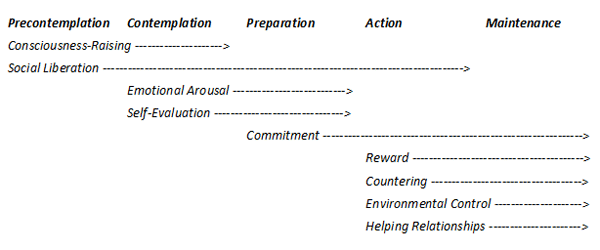Drs. James Prochaska, John Norcross, and Carlo DiClemente spent years working with clients who were ensnared by destructive personal habits. Time and time again, temporary behavioral adjustments just didn’t stick. Of New Year’s resolutions, 77% last for 1 week, 55% for 1 month, 40% for 2 months, and 19% for 2 years.
 So they combed the available research and conducted studies on their own to develop a solution to this vexing problem. They summarized findings in their seminal book Changing For Good: A Revolutionary Six-Stage Program for Overcoming Bad Habits and Moving Your Life Positively Forward.
So they combed the available research and conducted studies on their own to develop a solution to this vexing problem. They summarized findings in their seminal book Changing For Good: A Revolutionary Six-Stage Program for Overcoming Bad Habits and Moving Your Life Positively Forward.
As the book title indicates, the model identifies six stages of change. They are:
PRECONTEMPLATION: Individuals exhibit no intention of changing. Defenses include denial (“I don’t have a problem”), minimalization (“it’s not that bad”), rationalization (“everybody does it”), projection (“it’s not my fault”), and internalization (“I’m too weak to change”). External pressure and/or impactful events tend to provide the impetus for action.
CONTEMPLATION: Individuals acknowledge their issues and take initial steps toward a plan of action. They experience internal resistance based on a fear of failure and concern that their new selves won’t fit in with their environment. Individuals get stuck in this phase when they substitute planning for action, fixate on the need for certainty, or wait for the right moment to begin.
PREPARATION: During this phase, individuals devise the specific steps that they’ll follow during the action phase. Their plans may include grand gestures or a series of small steps, depending on the nature of their issues and personal predilections. This phase is also a time when they’ll commit to their personal transformation. Commitment presumes willingness to act and confidence in a favorable outcome.
ACTION: Individuals institute their plans and make adjustments as new opportunities and challenges present themselves. The biggest threats to sustained action include taking preparation lightly, lack of willingness to make the requisite sacrifices, believing in “silver bullets,” and/or doing the same old things and expecting different results.
MAINTENANCE: Successful behavioral maintenance demands long-term effort and revised lifestyles. In addition to distancing from unhealthy triggers, individuals should review their reasons for initiating change, acknowledge their successes, be brutally honest with themselves when facing temptation or missteps, and have support systems at the ready.
TERMINATION: Individuals have confidence in their ability to sustain change without temptation or reversion to old patterns. (I wonder if anyone truly reaches the stage at which sustained vigilance no longer becomes necessary…)
Drs. James Prochaska, John Norcross, and Carlo DiClemente also defined 9 change processes – i.e., activities that help individuals modify their thinking, feeling, or behavior:
- Consciousness raising through increased situational awareness and/or access to information
- Social liberation due to influences in the external environment that support change (e.g., an advocacy group)
- Emotional arousal caused by a significant experience that elevates one’s awareness, depth of feeling, or commitment
- Self-evaluation which results in a thoughtful appraisal of one’s circumstances and a vision of the person one might become when freed from the problem
- Commitment which comes from taking personal responsibility (privately, then publicly) for the problem and execution of a viable action plan
- Countering which entails substituting healthy behaviors for unhealthy ones
- Environmental control which minimizes the possibility of a problem-causing event
- Rewards that reinforce positive behavioral change
- Helping relationships that provide assurance, support, understanding, and acceptance.
Exhaustive research suggests that successful change entails use of the right processes at the right stages of change, as follows:
Change is not a linear process. It often entails two steps forward, one step back. Here are a few lessons that the authors have learned to help patients persevere:
- Take heart. Only 20% of the population conquers long-term issues permanently on the first attempt.
- A lapse is not a relapse. We can recover from slips, learn from them, and continue toward our goal of permanent change.
- Guilt and self-blame undermine confidence in the ability to succeed. Learn to silence them by simply re-engaging positive behaviors and moving forward.
- Change takes more time, energy, and money than we anticipate. Be patient. And consider all 6 change processes during the action phase. (Will power alone won’t get it done!)
- Don’t use the wrong change processes at the wrong time. It risks instilling misinformation, depleting will power, or substituting one bad behavior for another.
- Be prepared for complications and learn to be nimble when addressing them.
- Beware of mini-decisions that become maxi-decisions (“I’ll just keep some chips and cookies in the cupboard for company”).
- Because distress (anger, anxiety, depression, loneliness, social pressures) encourages relapse, be sure to have concrete plans to address them before they take root.
